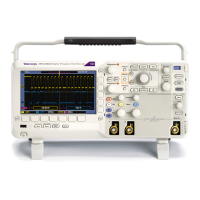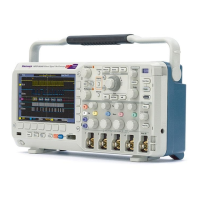Acquire the Sign
al
7. Turn m u ltipur p
ose knob a to scroll through
the list of digital channels. Turn multipurpose
knob b to position the selected channel.
As you positio
n channels close to each other
on the display, the oscilloscope groups the
channels, and adds the group to the pop-up
list. You can
select the g roup from the list to
move all the channels in the group instead
of individual channels.
8. Push the low
er-bezel Thresholds button.
You can assign a different threshold value
to each pod.
9. Push the lo
wer-bezel Edit Labels button
and create the label. You can create labels
through the front panel or with an optional
USB keyboa
rd. (See page 41, Labeling
Channels and Buses.)
10. P ush the lower-bezel Height button
repeated
ly to set the signal height. You only
need to do this once to set the height for all
of the digital channels.
Quick Tip
Use the zoom feature to see multiple cycles of the signal in the upper part, and a single cycle in the lower part of the
display. (See page 105, Using Wave Inspector to Manage Long Record Length Waveforms.)
The lead for each digital channel has a color-coded band for easy identification. The ground leads are shorter and
have black wires.
Digital channels store a high or low state for each sample. The threshold that separates a high from a low can be set for
all the channels in GROUP 1 or in GROUP 2. The threshold can not be set for individual channels.
Reducing Unwanted Noise With FilterVu
You can use FilterVu to filter unwanted noise from your signal and still capture glitches. The oscilloscope does this by
supe
rimposing a fi ltered foreground waveform over a glitch capture background waveform.
The fi
ltered waveform uses a variable low-pass filter to block out noise, yielding a cleaner waveform. When the noise filter is
adjusted to the minimum bandwidth setting, no more than 1% of high-frequency content that could cause the oscilloscope
to alias will pass through the filter.
The glitch capture waveform shows signal details up to the full bandwidth of the oscilloscope. The oscilloscope captures
pul
ses as narrow as 5 ns, using peak detect min/max sampling.
Wh
en your signal is fi ltered, the glitch capture waveform changes color to distinguish it from the filtered waveform. When
the signal is filtered, you can independently adjust the intensity of the glitch capture waveform. When the signal is not
filtered, the i ntensity of the glitch capture waveform depends on the overall intensity (under the Intensity button on the
os
cilloscope front panel).
60 MSO2000B and DPO2000B Series Oscilloscopes User Manual

